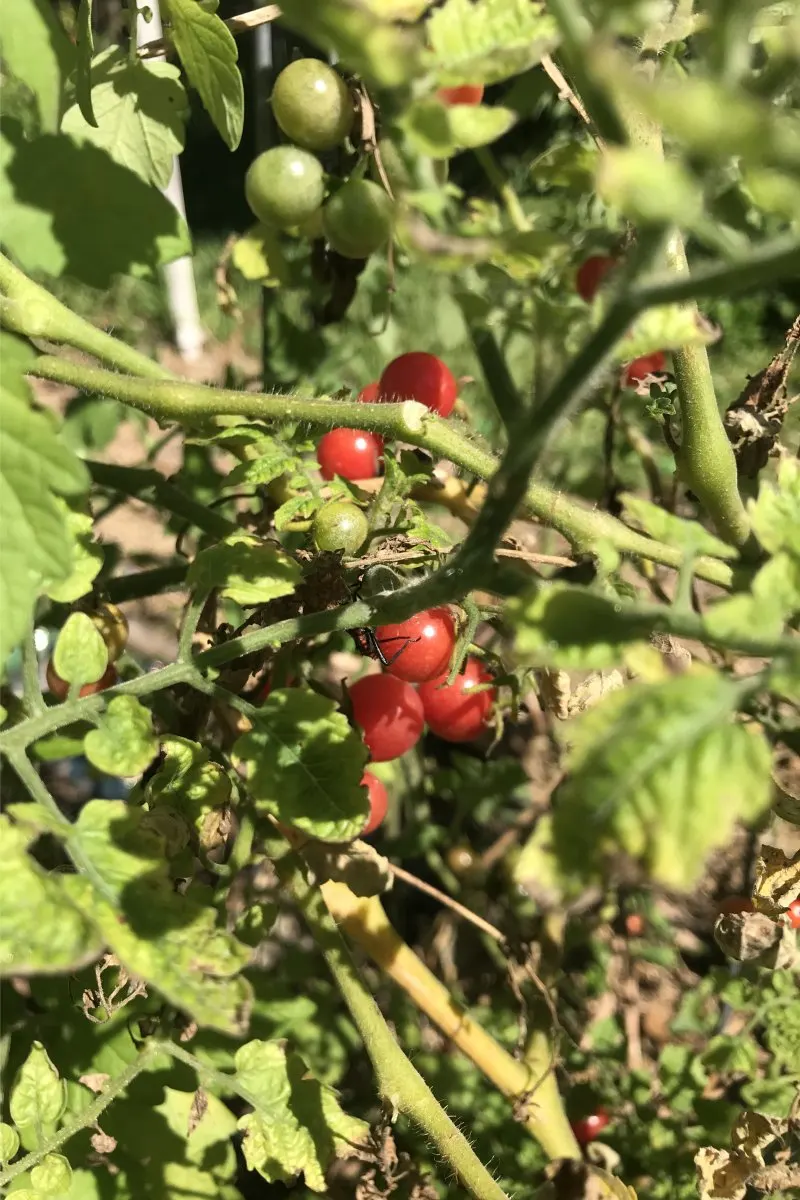
NOAA, the National Oceanic and Atmospheric Administration, has been tracking temperatures since 1850, and one thing is clear – record-breaking temperatures are on the rise. While the cause of climate change may be a subject of debate, increasing temperatures are a fact of life. For those of us who garden, they can also force us to make drastic changes in how we plan our crops.
Take Tomatoes, For Example

Tomatoes are the classic summer vegetable and the star of many hot-weather menus.
We’ve even created a whole cooking style around the beloved tomato. Although Texas isn’t onboard, most Americans think about sweet and tangy tomato-based barbecue sauces when they plan their weekend cookouts.
However, rising temperatures can severely affect tomato production.
In 2021, commercial tomato growers found a combination of increased heat and lower rainfall resulted in a 1.3 million ton reduction in crop yield.
But tomatoes LOVE hot weather, right?
Well, yes, but it’s more complicated than that.
Most plants suffer from heat stress, but tomatoes’ problem with elevated temperatures is that they can significantly impact blossoming and fruit set.
Tomatoes may tolerate hot weather just fine, but they don’t fruit.
Tracey has more on the link between extreme heat and slowed tomato production here.
Planting for Resilience

So, what are tomato fans to do as summer temperatures continue to rise?
Many home gardeners—as well as commercial farmers—have adjusted their planting schedules, especially in light of the major shifts in growing zones after the USDA released an updated map last year.
You may need to plant out your spring tomatoes a month earlier or your fall tomatoes a month later.
Or, you could switch to a more heat-resilient variety, like the Everglades wild tomato, during the hottest months.
Sow Your Wild Tomatoes
Solanum pimpinellifolium, sometimes called “pimps” for short, is the original species for all modern domestic tomatoes. Several wild varieties are still under cultivation and are usually called “currant tomatoes.”
Wild tomatoes vary so completely from domestic tomatoes that they’re two distinct species. Modern tomatoes are classified as “Solanum lycopersicum.”
Wild tomatoes were popular forage for people and animals in South America, But once they reached Mexico, indigenous farmers started selectively breeding them for size and flavor.
Europeans fell in love with these savory fruits and took them back to the Old World, where they eventually were bred into the standard tomato types we know so well today.
Everglades – North America’s Only “Native Tomato”

The Everglades variety is a descendant of S. pimpinellifolium from Peru and was transported to South Florida by European explorers. From there, it became naturalized and spread throughout the state.
These are the wild tomatoes that never made it to Spain.
There is some debate over whether Everglades hybridized with modern tomatoes because they can vary in size and color from fruit to fruit more than other types of wild tomatoes.
I’m a romantic, though, and I want to believe they’re just rugged non-conformists, like other Floridians.
Take A Walk on The Wild Side
So, what’s so great about Everglades tomatoes, and why should you consider growing them?
- Abundant harvests
- Superb flavor
- Increased nutrition
- Heat resistance
- Disease resistance
- Low effort crops
- Practically immortal
Let’s take a look at these factors one by one.
Abundant Harvests

Wild Everglades tomatoes are prolific. If they can continue to produce abundantly despite 100°F temperatures, imagine what they’re like when conditions are optimal.
Everglades tomatoes are small but mighty. And the fast-growing, sprawling foliage produces such a plethora of tiny tomatoes that you’ll be looking for new ways to use them.
This is just anecdotal, but with just three plants in production, I accumulated several gallon-size bags of tiny tomatoes in my freezer after two months of regular harvesting.
And the plants weren’t nearly finished with me yet.
Superb Flavor

Who says small tomatoes are only good for salads?
Because I ran out of freezer space, I converted those gallon bags into barbecue sauce.
You see, most cherry or grape-sized tomatoes are a bit bland or overly sweet.
Not Everglades.
They carry the same rich tang of well-ripened slicers with plenty of umami. Everglades deliver an intense burst of flavor, unlike other small tomatoes.
This makes them superior for making tomato-based condiments.
They’re far too tiny to process like other canning tomatoes. So, my advice is to get yourself a food mill to screen out the skins and seeds.
Increased Nutrition
Everglades tomatoes and other wild tomato species may offer better nutrition than the highly cultivated modern tomato.
S. pimpinellifolium delivers more β-carotene, lycopene, vitamin C, vitamin E and other antioxidants than regular tomatoes.
Lycopene, in particular, has proven to help prevent bone loss in post-menopausal women and inhibit the growth of prostate cancer cells in men.
Heat Resistance

Research has found excessive temperatures affect tomato production by interfering with pollination.
Each bloom has only 24 to 48 hours to achieve pollination. If temperatures are too high during this critical period, the pollen is denatured and fails in its important work, resulting in blossom drop.
Last year, scientists gene-mapped the most heat-tolerant tomato breeds to learn what made them successful in high temperatures.
One tomato type (E42) consistently produced more fruit during two sequential summer seasons, despite temperatures ranging from 89.6°F to 100.4°F.
When they reverse-engineered this ability, they found the plant’s ability to flower and fruit despite excessive heat was derived from their S. pimpinellifolium ancestry.
While the study’s main purpose was to identify candidate species for future genetic modification, there’s no reason why home gardeners can’t plant their own Everglades wild tomatoes right now.
Disease Resistance
Along with better resistance to heat stress, S pimpinellifolium also gifted its resistance to disease to many modern varieties.
Plant geneticists determined that cultivated varieties resistant to tomato leaf curl (spread by whiteflies) owe their resilience to these wild tomato ancestors.
S pimpinellifolium is also resistant to late blight, thanks to 60 different genes they carry. This infectious spore can spread like wildfire through your garden, killing off tomatoes, potatoes, and other sensitive nightshade plants.
It can even take out your petunias!
Low Effort Crops
Because of the plant’s natural disease resistance, you won’t spend hours in the hot sun trellising them up off the ground.
And since they’re a wild “native” plant, they haven’t been bred to need much water after they’re established. They usually don’t need much fertilizer to fruit.
While they appreciate the effort, neither are necessary unless you’re in a drought or trying to grow them in beach sand.
Practically Immortal

The standard method of distribution for Everglades tomato seeds over the last decade or so is by asking someone in the local area for seeds.
This is usually accomplished by the gracious seed-sharer squeezing a couple of tomatoes onto a paper towel, letting it dry, and stuffing the whole thing into a SASE.
For this reason, the exact characteristics of the plants in circulation are not well documented.
Even the hardiest of tomatoes wouldn’t be perennial in Zones 7 and up, anyway. But the thing that makes them “practically immortal” is their prolific self-seeding capability.
And this happens in temperate zones, as well.
I followed the same method to share some Everglades tomato seeds with my brother in St. Louis, MO, which was Zone 6b at the time.
I think he’s still getting volunteers every summer.
Acquiring Everglades Tomato Seeds
After the pandemic-era gardening boom, Everglades tomato seeds started to appear for sale online.
Because Everglades have only recently become popular, they haven’t yet been bred to a standard. They retain most of their wild characteristics and aren’t as reliable as tomato seeds that have been carefully controlled and documented for several generations before release to the market.
The true origins of most Everglades seeds for sale online usually involve a passing Blue Jay and an excited home gardener who found a “wild tomato” volunteer in their yard.
If you can’t find someone offering Everglades tomato seeds online, then Baker Creek has a similar offering with their ‘Spoon Tomato’ variety. (Also, a member of the Solanum pimpinellifolium family.)
Downsides to Everglades Tomatoes
Everglades tomatoes fill a very specific and important niche in the home garden. They resist disease and pump out thousands of tiny tomatoes even during the dog days of summer.
But they’re not perfect, and they definitely have a few downsides.
Slow Germination
It’s important to understand that germination for Everglades is usually slow compared to traditionally cultivated tomatoes. As a distinct and separate species, S pimpinellifolium seeds don’t germinate and grow the same way S. lycopersicum seeds do.
I’ve seen many well-meaning seed sellers online get poor reviews due to bad germination. The problem is Everglades can take up to a month to germinate; sometimes even longer.

As a wild variety, Everglades tomatoes are simply unpredictable.
Short Shelf Life

Everglades tomatoes are perfect for picking and eating immediately. They don’t transport well, which is why you never see them in grocery stores. You can freeze them for cooking later, but they’re best eaten fresh the same day you’ve picked them.
Everglades tomato skins often tear when removed from the stems. The fruits form symmetrically arranged clusters along a central stem. The best way to harvest them is to cut these clusters from the plant to prevent those skins from splitting.
If all the fruits on the stem aren’t ripe, you can leave them on the stem to ripen for a day, since no split skin means they have a longer shelf life.
Size Considerations

The plants are huge, and the fruits are small. Only 1/2 to 1 inch in diameter, it can take a lot of them to equal a regular tomato.
Everglades try to compensate with volume, but that’s not every gardener’s preference. They’ll never replace monster slicers like “Mortgage Lifters.”
The plants themselves take up a lot of room in the garden when allowed to grow naturally.
To produce so prolifically, they need room to sprawl. They can grow up to 12 feet long with lots of side branching, but mainly, they like to grow in huge, messy, wide clumps.
The more branching and sprawling, the more tomatoes you’ll get.
I don’t usually trellis mine. Sometimes, I tie them up to climb the chicken enclosure, where my girls can harvest the fallen fruits.
I also let them sprawl over standard tomato cages to make harvesting easier. The verdant nature of the plant can hide a wealth of tiny red gems beneath its many branches.

This is usually where you’ll find volunteers over the next few years.
Grow These Hot Climate Heroes
Everglades tomatoes aren’t perfect, but in the deep South and the deep days of summer, they can really shine.
You don’t need to live in a sweltering region to enjoy their intense flavor, though. In temperate climates, start them indoors about 8 to 10 weeks before your last frost date. They should only need about 90 days before they start producing fruits.
Here in the subtropics, the volunteers tend to pop up at random times throughout the year, depending on the mildness of winter. If you live in Zones 9 through 11, you may want to avoid planting out delicate seedlings in December and January. Otherwise, you should be able to grow them year-round.

Get the famous Rural Sprout newsletter delivered to your inbox.
Including Sunday musings from our editor, Tracey, as well as “What’s Up Wednesday” our roundup of what’s in season and new article updates and alerts.


